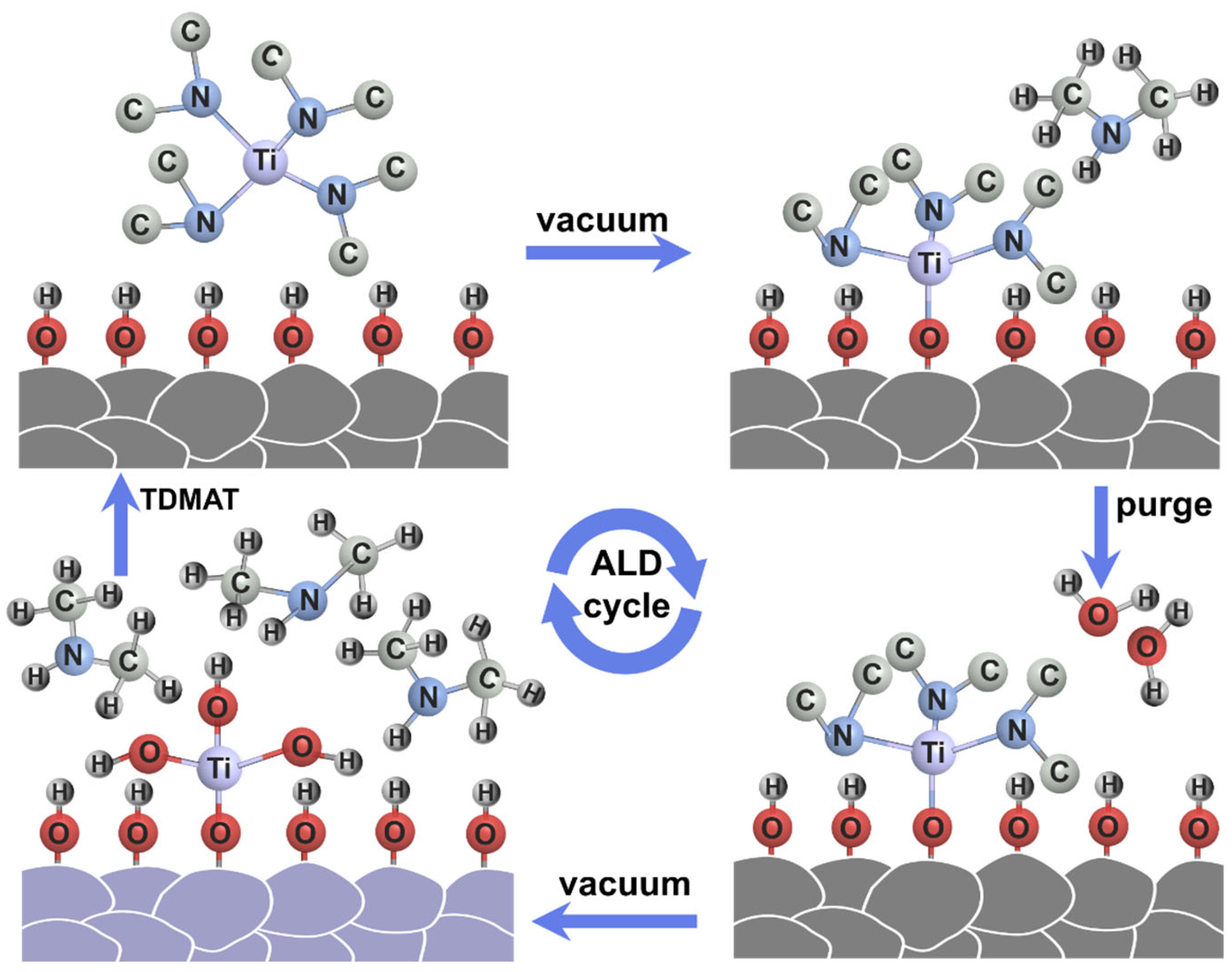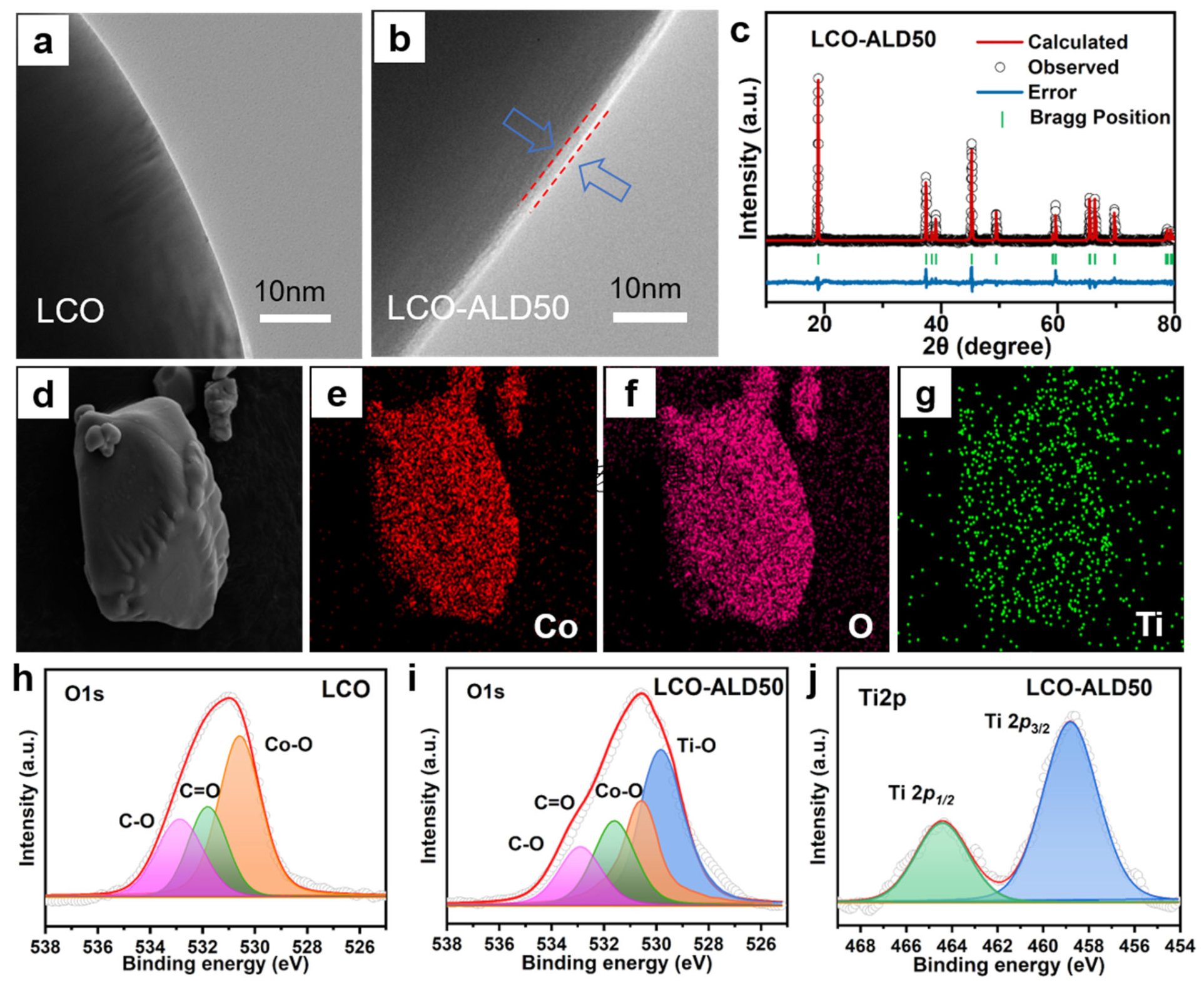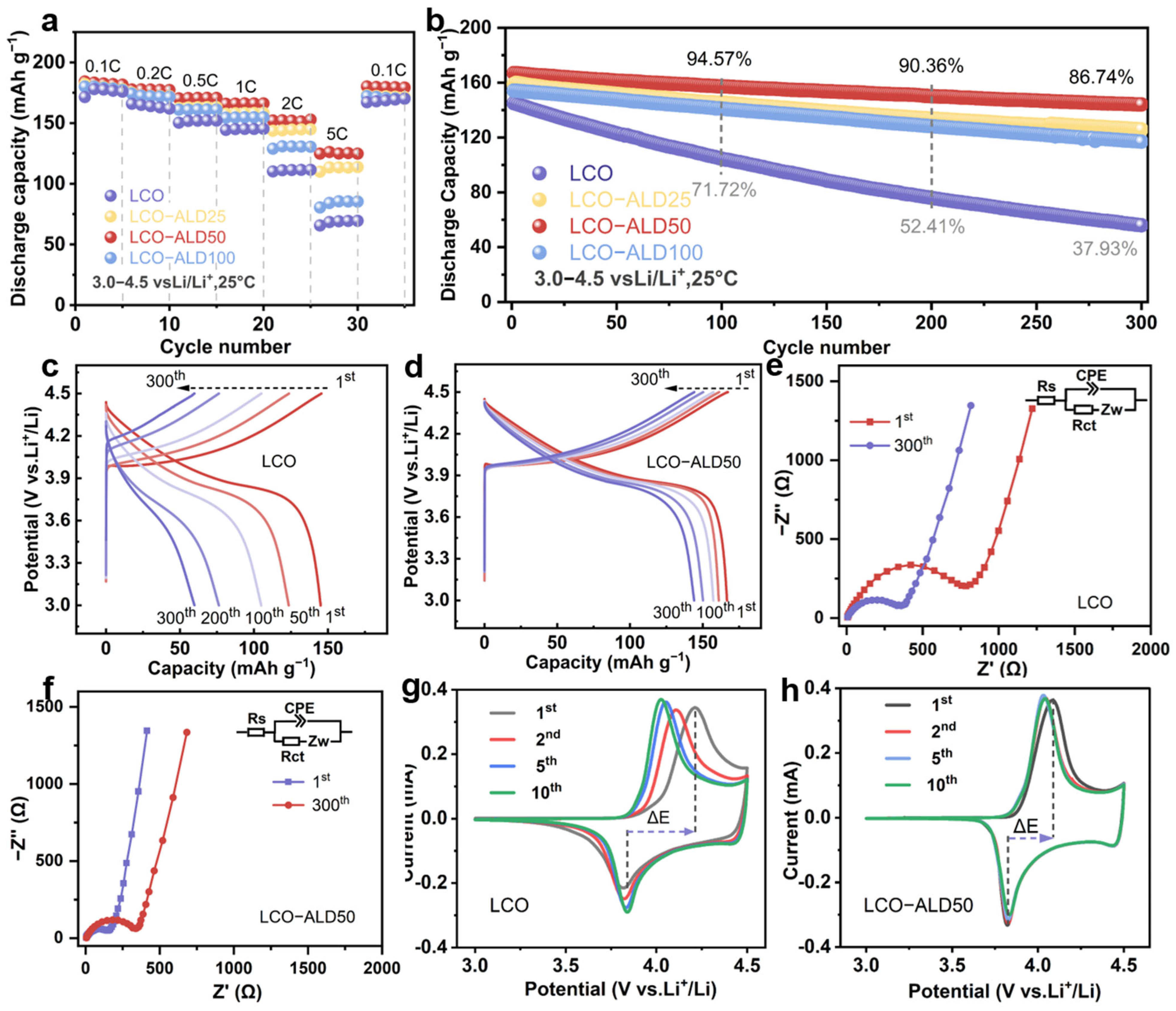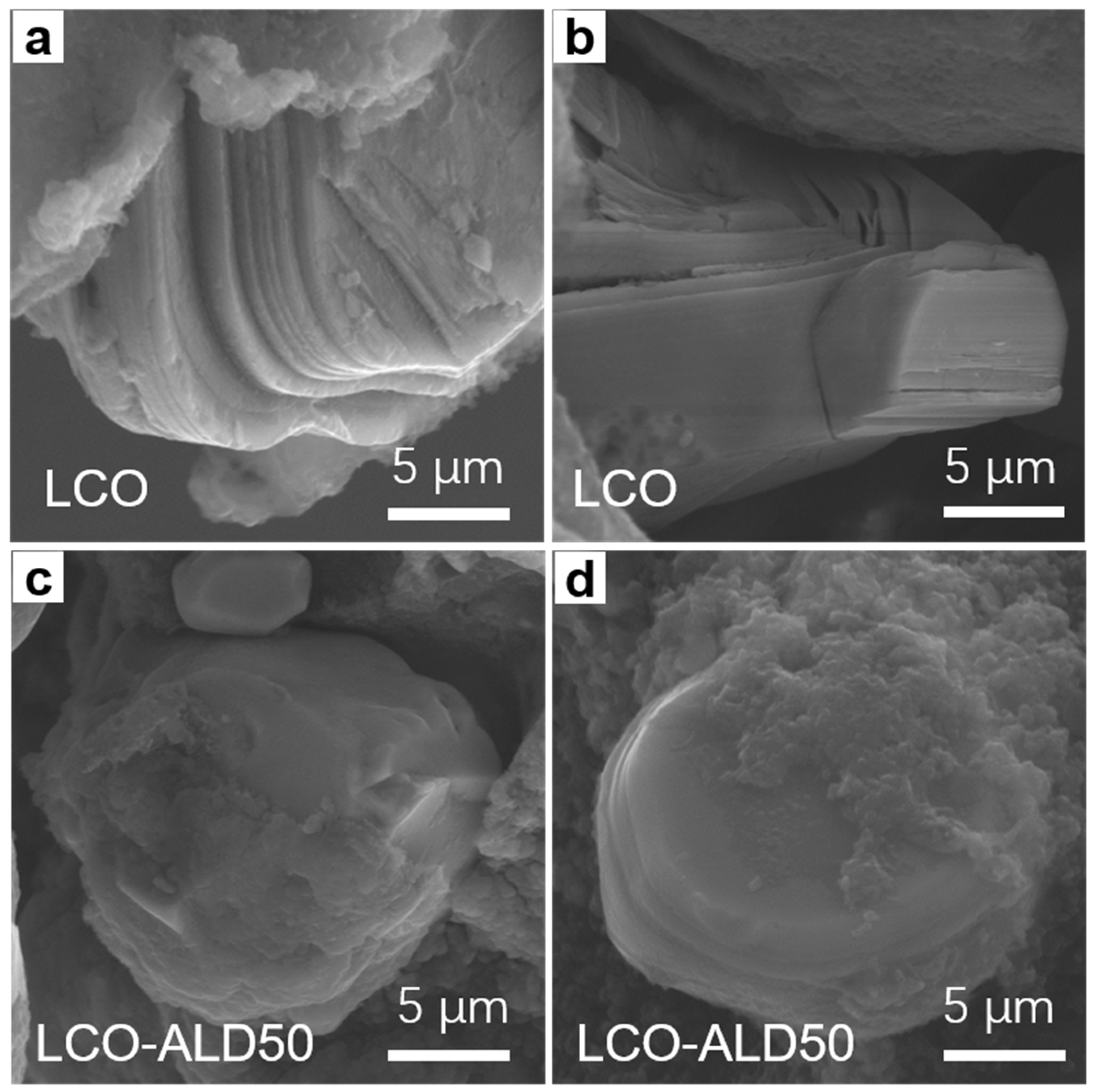Ultrathin Titanium Dioxide Coating Enables High-Rate and Long-Life Lithium Cobalt Oxide
Abstract
:1. Introduction
2. Materials and Methods
3. Results and Discussion
4. Conclusions
Supplementary Materials
Author Contributions
Funding
Institutional Review Board Statement
Informed Consent Statement
Data Availability Statement
Conflicts of Interest
References
- Lin, C.; Li, J.; Yin, Z.W.; Huang, W.; Zhao, Q.; Weng, Q.; Liu, Q.; Sun, J.; Chen, G.; Pan, F. Structural Understanding for High-Voltage Stabilization of Lithium Cobalt Oxide. Adv. Mater. 2024, 36, 2307404. [Google Scholar] [CrossRef] [PubMed]
- Zhang, H.; Liu, H.; Piper, L.F.J.; Whittingham, M.S.; Zhou, G. Oxygen Loss in Layered Oxide Cathodes for Li-Ion Batteries: Mechanisms, Effects, and Mitigation. Chem. Rev. 2022, 122, 5641–5681. [Google Scholar] [CrossRef] [PubMed]
- Konar, R.; Maiti, S.; Shpigel, N.; Aurbach, D. Reviewing Failure Mechanisms and Modification Strategies in Stabilizing High-Voltage LiCoO2 Cathodes beyond 4.55V. Energy Storage Mater. 2023, 63, 103001. [Google Scholar] [CrossRef]
- Zhuang, Z.; Wang, J.; Jia, K.; Ji, G.; Ma, J.; Han, Z.; Piao, Z.; Gao, R.; Ji, H.; Zhong, X.; et al. Ultrahigh-Voltage LiCoO2 at 4.7 V by Interface Stabilization and Band Structure Modification. Adv. Mater. 2023, 35, 2212059. [Google Scholar] [CrossRef] [PubMed]
- Wu, N.; Zhang, Y.; Guo, Y.; Liu, S.; Liu, H.; Wu, H. Flakelike LiCoO2 with Exposed {010} Facets As a Stable Cathode Material for Highly Reversible Lithium Storage. ACS Appl. Mater. Interfaces 2016, 8, 2723–2731. [Google Scholar] [CrossRef] [PubMed]
- Xu, S.; Tan, X.; Ding, W.; Ren, W.; Zhao, Q.; Huang, W.; Liu, J.; Qi, R.; Zhang, Y.; Yang, J.; et al. Promoting Surface Electric Conductivity for High-Rate LiCoO2. Angew. Chem. Int. Ed. 2023, 62, 2218595. [Google Scholar]
- Zhang, J.; Wong, D.; Zhang, Q.; Zhang, N.; Schulz, C.; Bartkowiak, M.; An, K.; Gu, L.; Hu, Z.; Liu, X. Reducing Co/O Band Overlap through Spin State Modulation for Stabilized High Capability of 4.6 V LiCoO2. J. Am. Chem. Soc. 2023, 145, 10208–10219. [Google Scholar] [CrossRef] [PubMed]
- Takamatsu, D.; Orikasa, Y.; Mori, S.; Nakatsutsumi, T.; Yamamoto, K.; Koyama, Y.; Minato, T.; Hirano, T.; Tanida, H.; Arai, H.; et al. Effect of an Electrolyte Additive of Vinylene Carbonate on the Electronic Structure at the Surface of a Lithium Cobalt Oxide Electrode under Battery Operating Conditions. J. Phys. Chem. C 2015, 119, 9791–9797. [Google Scholar] [CrossRef]
- Zhang, J.N.; Li, Q.; Ouyang, C.; Yu, X.; Ge, M.; Huang, X.; Hu, E.; Ma, C.; Li, S.; Xiao, R.; et al. Trace Doping of Multiple Elements Enables Stable Battery Cycling of LiCoO2 at 4.6 V. Nat. Energy 2019, 4, 594–603. [Google Scholar] [CrossRef]
- Wang, Y.; Zhang, Q.; Xue, Z.C.; Yang, L.; Wang, J.; Meng, F.; Li, Q.; Pan, H.; Zhang, J.N.; Jiang, Z.; et al. An In Situ Formed Surface Coating Layer Enabling LiCoO2 with Stable 4.6 V High-Voltage Cycle Performances. Adv. Energy Mater. 2020, 10, 2001413. [Google Scholar] [CrossRef]
- Zhang, C.; Shen, X.; Li, X.; Liu, Q.; Liu, Z.; Huang, Y.; Gao, Y.; Hu, Z.; Chen, J.M.; Yang, Y.; et al. Quenching-Etched Surface Spinel to Passivate Layered Cathode Materials from Structural Degradation at High Potentials. Chem. Mater. 2023, 35, 6692–6701. [Google Scholar] [CrossRef]
- Zhou, H.; Izumi, J.; Asano, S.; Ito, K.; Watanabe, K.; Suzuki, K.; Nemoto, F.; Yamada, N.L.; Aso, K.; Oshima, Y.; et al. Fast Lithium Intercalation Mechanism on Surface-Modified Cathodes for Lithium-Ion Batteries. Adv. Energy Mater. 2023, 13, 2302402. [Google Scholar] [CrossRef]
- Wu, R.; Cao, T.; Liu, H.; Cheng, X.; Liu, X.; Zhang, Y. Ultralong Lifespan for High-Voltage LiCoO2 Enabled by in Situ Reconstruction of an Atomic Layer Deposition Coating Layer. ACS Appl. Mater. Interfaces 2022, 14, 25524–25533. [Google Scholar] [CrossRef] [PubMed]
- Dong, W.; Ye, B.; Cai, M.; Bai, Y.; Xie, M.; Sun, X.; Lv, Z.; Huang, F. Superwettable High-Voltage LiCoO2 for Low-Temperature Lithium Ion Batteries. ACS Energy Lett. 2023, 8, 881–888. [Google Scholar] [CrossRef]
- Wang, Z.; Dai, X.; Chen, H.; Wu, F.; Mai, Y.; Li, S.; Gu, Y.; Li, J.; Zhou, A. Simultaneously Constructing a TiO2-LiF Composite Coating Enhancing the Cycling Stability of LiCoO2 at 4.6 V High Voltage. ACS Sustain. Chem. Eng. 2022, 10, 8151–8161. [Google Scholar] [CrossRef]
- Xu, L.; Cheng, S.; Niu, H.; Wang, Z. Understanding the Role of TiO2 Coating for Stabilizing 4.6V High-Voltage LiCoO2 Cathode Materials. Electrochim. Acta 2024, 478, 143862. [Google Scholar] [CrossRef]
- Zhou, A.; Lu, Y.; Wang, Q.; Xu, J.; Wang, W.; Dai, X.; Li, J. Sputtering TiO2 on LiCoO2 Composite Electrodes as a Simple and Effective Coating to Enhance High-Voltage Cathode Performance. J. Power Sources 2017, 346, 24–30. [Google Scholar] [CrossRef]
- Cho, Y.; Eom, J.; Cho, J. High Performance LiCoO2 Cathode Materials at 60 °C for Lithium Secondary Batteries Prepared by the Facile Nanoscale Dry-Coating Method. J. Electrochem. Soc. 2010, 157, A617. [Google Scholar] [CrossRef]
- Moon, S.H.; Kim, M.C.; Kim, E.S.; Shin, Y.K.; Lee, J.E.; Choi, S.; Park, K.W. TiO2-Coated LiCoO2 Electrodes Fabricated by a Sputtering Deposition Method for Lithium-Ion Batteries with Enhanced Electrochemical Performance. RSC Adv. 2019, 9, 7903–7907. [Google Scholar] [CrossRef]
- Ren, H.; Zhao, W.; Yi, H.; Chen, Z.; Ji, H.; Jun, Q.; Ding, W.; Li, Z.; Shang, M.; Fang, J.; et al. One-Step Sintering Synthesis Achieving Multiple Structure Modulations for High-Voltage LiCoO2. Adv. Funct. Mater. 2023, 33, 2302622. [Google Scholar] [CrossRef]
- Huang, Y.; Zhu, Y.; Fu, H.; Ou, M.; Hu, C.; Yu, S.; Hu, Z.; Chen, C.T.; Jiang, G.; Gu, H.; et al. Mg-Pillared LiCoO2: Towards Stable Cycling at 4.6 V. Angew. Chem. Int. Ed. 2021, 60, 4682–4688. [Google Scholar] [CrossRef]
- Chen, J.; Chen, H.; Zhang, S.; Dai, A.; Li, T.; Mei, Y.; Ni, L.; Gao, X.; Deng, W.; Yu, L.; et al. Structure/Interface Coupling Effect for High-Voltage LiCoO2 Cathodes. Adv. Mater. 2022, 34, 2204845. [Google Scholar] [CrossRef] [PubMed]
- Wang, C.; Zhang, J.; Wang, X.; Lin, C.; Zhao, X.S. Hollow Rutile Cuboid Arrays Grown on Carbon Fiber Cloth as a Flexible Electrode for Sodium-Ion Batteries. Adv. Funct. Mater. 2020, 30, 2002629. [Google Scholar] [CrossRef]
- Jia, R.; Zhang, R.; Yu, L.; Kong, X.; Bao, S.; Tu, M.; Liu, X.; Xu, B. Engineering a Hierarchical Carbon Supported Magnetite Nanoparticles Composite from Metal Organic Framework and Graphene Oxide for Lithium-Ion Storage. J. Colloid Interface Sci. 2023, 630, 86–98. [Google Scholar] [CrossRef] [PubMed]
- Ting-Kuo Fey, G.; Lu, C.Z.; Prem Kumar, T.; Chang, Y.C. TiO2 Coating for Long-Cycling LiCoO2: A Comparison of Coating Procedures. Surf. Coat. Technol. 2005, 199, 22–31. [Google Scholar] [CrossRef]
- Su, L.; Jha, S.K.; Phuah, X.L.; Xu, J.; Nakamura, N.; Wang, H.; Okasinski, J.S.; Reeja-Jayan, B. Engineering Lithium-Ion Battery Cathodes for High-Voltage Applications Using Electromagnetic Excitation. J. Mater. Sci. 2020, 55, 12177–12190. [Google Scholar] [CrossRef]
- Cheng, H.M.; Wang, F.M.; Chu, J.P.; Santhanam, R.; Rick, J.; Lo, S.C. Enhanced Cycleabity in Lithium Ion Batteries: Resulting from Atomic Layer Depostion of Al2O3 or TiO2 on LiCoO2 Electrodes. J. Phys. Chem. C 2012, 116, 7629–7637. [Google Scholar] [CrossRef]
- Jayasree, S.S.; Nair, S.; Santhanagopalan, D. Ultrathin TiO2 Coating on LiCoO2 for Improved Electrochemical Performance as Li–Ion Battery Cathode. ChemistrySelect 2018, 3, 2763–2766. [Google Scholar] [CrossRef]
- Wang, Q.; Wang, C.; Zheng, K.; Wang, B.; Wang, Z.; Zhang, C.; Long, X. Positional Thiophene Isomerization: A Geometric Strategy for Precisely Regulating the Electronic State of Covalent Organic Frameworks to Boost Oxygen Reduction. Angew. Chem. Int. Ed. 2024, 63, 2320037. [Google Scholar]
- Shin, B.H.; Kim, S.; Park, J.; Ok, J.W.; Kim, D.I.; Kim, D.; Yoon, J.H. Effect of Secondary Phase on Electroless Ni Plating Behaviour of Super Duplex Stainless Steel SAF2507 for Advanced Li-Ion Battery Case. Materials 2024, 17, 1441. [Google Scholar] [CrossRef]
- Xiao, Z.; Gao, L.; Li, S. Engineering Heterostructured Fe-Co-P Arrays for Robust Sodium Storage. Materials 2024, 17, 1616. [Google Scholar] [CrossRef] [PubMed]
- Yang, X.; Wang, C.; Yan, P.; Jiao, T.; Hao, J.; Jiang, Y.; Ren, F.; Zhang, W.; Zheng, J.; Cheng, Y.; et al. Pushing Lithium Cobalt Oxides to 4.7 V by Lattice-Matched Interfacial Engineering. Adv. Energy Mater. 2022, 12, 2200197. [Google Scholar] [CrossRef]
- Li, J.; Lin, C.; Weng, M.; Qiu, Y.; Chen, P.; Yang, K.; Huang, W.; Hong, Y.; Li, J.; Zhang, M.; et al. Structural Origin of the High-Voltage Instability of Lithium Cobalt Oxide. Nat. Nanotechnol. 2021, 16, 599–605. [Google Scholar] [CrossRef] [PubMed]
- Zheng, J.; Wang, Y.; Qin, M.; Sun, L.; Peng, C.; Li, Y.; Feng, W. Epitaxial Growth of a Single Hexagonal Layered α-LiAlO2 Coating on a High-Voltage LiCoO2 Cathode Material for Enhanced Stability. J. Mater. Chem. A 2023, 11, 10297–10308. [Google Scholar] [CrossRef]
- Wang, P.; Meng, Y.; Wang, Y.; Chen, L.; Zhang, Z.; Pu, W.; Li, J.; Yang, C.; Xiao, D. Oxygen Framework Reconstruction by LiAlH4 Treatment Enabling Stable Cycling of High-Voltage LiCoO2. Energy Storage Mater. 2022, 44, 487–496. [Google Scholar] [CrossRef]
- Li, Y.; Zan, M.; Chen, P.; Huang, Y.; Xu, X.; Zhang, C.; Cai, Z.; Yu, X.; Li, H. Facile Solid-State Synthesis to In Situ Generate a Composite Coating Layer Composed of Spinel-Structural Compounds and Li3PO4 for Stable Cycling of LiCoO2 at 4.6 V. ACS Appl. Mater. Interfaces 2023, 15, 51262–51273. [Google Scholar] [CrossRef]





Disclaimer/Publisher’s Note: The statements, opinions and data contained in all publications are solely those of the individual author(s) and contributor(s) and not of MDPI and/or the editor(s). MDPI and/or the editor(s) disclaim responsibility for any injury to people or property resulting from any ideas, methods, instructions or products referred to in the content. |
© 2024 by the authors. Licensee MDPI, Basel, Switzerland. This article is an open access article distributed under the terms and conditions of the Creative Commons Attribution (CC BY) license (https://creativecommons.org/licenses/by/4.0/).
Share and Cite
Gao, L.; Jin, X.; Li, Z.; Li, F.; Xu, B.; Wang, C. Ultrathin Titanium Dioxide Coating Enables High-Rate and Long-Life Lithium Cobalt Oxide. Materials 2024, 17, 3036. https://doi.org/10.3390/ma17123036
Gao L, Jin X, Li Z, Li F, Xu B, Wang C. Ultrathin Titanium Dioxide Coating Enables High-Rate and Long-Life Lithium Cobalt Oxide. Materials. 2024; 17(12):3036. https://doi.org/10.3390/ma17123036
Chicago/Turabian StyleGao, Liu, Xin Jin, Zijin Li, Fujie Li, Binghui Xu, and Chao Wang. 2024. "Ultrathin Titanium Dioxide Coating Enables High-Rate and Long-Life Lithium Cobalt Oxide" Materials 17, no. 12: 3036. https://doi.org/10.3390/ma17123036






